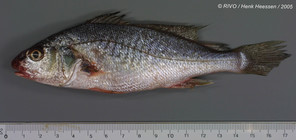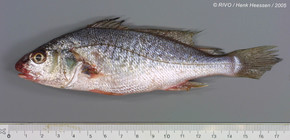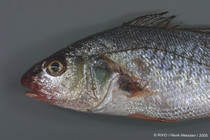
| Introduction | | Search taxa | | Taxon tree | | Taxon match | | Checklist | | Literature | | Stats | | Photogallery | | OBIS Vocab | | Log in |
WoRMS taxon detailsMicropogonias undulatus (Linnaeus, 1766)
151158 (urn:lsid:marinespecies.org:taxname:151158)
accepted
Species
Bodianus costatus Mitchill, 1815 · unaccepted
Micropogon lineatus Cuvier, 1830 · unaccepted
Micropogon undulatus (Linnaeus, 1766) · unaccepted
Perca undulata Linnaeus, 1766 · unaccepted
Sciaena croker Lacepède, 1802 · unaccepted
marine, brackish,
(of Perca undulata Linnaeus, 1766) Linnaeus, C. (1767). Systema naturae per regna tria naturae: secundum classes, ordines, genera, species, cum characteribus, differentiis, synonymis, locis. Ed. 12. 1., Regnum Animale. 1 & 2. <em>Holmiae [Stockholm], Laurentii Salvii.</em> pp. 1-532 [1766] pp. 533-1327 [1767]., available online at http://www.biodiversitylibrary.org/item/83650#5 [details]
Distribution American species, found for the first time in Belgian (and even European) waters in the night of 16 to 17 August 1998, a...
Distribution American species, found for the first time in Belgian (and even European) waters in the night of 16 to 17 August 1998, a second time in 2001 in the Zeeschelde [details] Distribution Western Atlantic: from 42.35°N to Massachusetts, USA (excluding Florida) and northern Gulf of Mexico to northern Mexico;...
Distribution Western Atlantic: from 42.35°N to Massachusetts, USA (excluding Florida) and northern Gulf of Mexico to northern Mexico; possibly from southern Brazil to Argentina. Uncertain in southern Gulf of Mexico, Lesser Antilles and southern Caribbean [details]
Froese, R. and D. Pauly. Editors. (2024). FishBase. Micropogonias undulatus (Linnaeus, 1766). Accessed through: World Register of Marine Species at: https://www.marinespecies.org/aphia.php?p=taxdetails&id=151158 on 2024-09-19
original description
(of Bodianus costatus Mitchill, 1815) Mitchill, S. L. (1815). The fishes of New-York, described and arranged. <em>Transactions of the Literary and Philosophical Society of New-York.</em> v. 1 (art. 5) (for 1814): 355-492, Pls. 1-6.
page(s): 417 [details] original description (of Sciaena croker Lacepède, 1802) Lacepède, B.G.E. (1802). Histoire naturelle des poissons: IV. <em>chez Plassan: Paris, France.</em> v. 4: i-xliv + 1-728, Pl. 1-16., available online at https://www.biodiversitylibrary.org/page/6705733 page(s): 309, 314 [details] original description (of Perca undulata Linnaeus, 1766) Linnaeus, C. (1767). Systema naturae per regna tria naturae: secundum classes, ordines, genera, species, cum characteribus, differentiis, synonymis, locis. Ed. 12. 1., Regnum Animale. 1 & 2. <em>Holmiae [Stockholm], Laurentii Salvii.</em> pp. 1-532 [1766] pp. 533-1327 [1767]., available online at http://www.biodiversitylibrary.org/item/83650#5 [details] original description (of Micropogon lineatus Cuvier, 1830) Cuvier, G. ; Valenciennes, A. (1830). Histoire naturelle des poissons. Tome cinquième. Livre cinquième. Des Sciénoïdes. Livre cinquième. Des Sciénoïdes. v. 5: i-xxviii + 1-499 + 4 pp., Pls. 100-140. [Cuvier authored volume. i-xx + 1-374 in Strasbourg edition.]. page(s): 215, Pls. 119, 138 (part) [details] context source (Introduced species) Katsanevakis, S.; Bogucarskis, K.; Gatto, F.; Vandekerkhove, J.; Deriu, I.; Cardoso A.S. (2012). Building the European Alien Species Information Network (EASIN): a novel approach for the exploration of distributed alien species data. <em>BioInvasions Records.</em> 1: 235-245., available online at http://easin.jrc.ec.europa.eu [details] Available for editors context source (Schelde) Maris, T.; Beauchard, O.; Van Damme, S.; Van den Bergh, E.; Wijnhoven, S.; Meire, P. (2013). Referentiematrices en Ecotoopoppervlaktes Annex bij de Evaluatiemethodiek Schelde-estuarium Studie naar “Ecotoopoppervlaktes en intactness index”. <em>Monitor Taskforce Publication Series, 2013-01. NIOZ: Yerseke.</em> 35 pp. (look up in IMIS) [details] basis of record Fricke, R., Eschmeyer, W. N. & Van der Laan, R. (eds). (2024). ECoF. Eschmeyer's Catalog of Fishes: Genera, Species, References. <em>California Academy of Sciences. San Francisco.</em> Electronic version accessed dd mmm 2024., available online at http://researcharchive.calacademy.org/research/Ichthyology/catalog/fishcatmain.asp [details] additional source Froese, R. & D. Pauly (Editors). (2023). FishBase. World Wide Web electronic publication. version (02/2023)., available online at https://www.fishbase.org [details] additional source Gulf of Maine Biogeographic Information System (GMBIS) Electronic Atlas. 2002. November, 2002. [details] additional source Muller, Y. (2004). Faune et flore du littoral du Nord, du Pas-de-Calais et de la Belgique: inventaire. [Coastal fauna and flora of the Nord, Pas-de-Calais and Belgium: inventory]. <em>Commission Régionale de Biologie Région Nord Pas-de-Calais: France.</em> 307 pp., available online at http://www.vliz.be/imisdocs/publications/145561.pdf [details] additional source McEachran, J. D. (2009). Fishes (Vertebrata: Pisces) of the Gulf of Mexico, Pp. 1223–1316 in: Felder, D.L. and D.K. Camp (eds.), Gulf of Mexico–Origins, Waters, and Biota. Biodiversity. Texas A&M Press, College Station, Texas. [details] ecology source Looby, A.; Erbe, C.; Bravo, S.; Cox, K.; Davies, H. L.; Di Iorio, L.; Jézéquel, Y.; Juanes, F.; Martin, C. W.; Mooney, T. A.; Radford, C.; Reynolds, L. K.; Rice, A. N.; Riera, A.; Rountree, R.; Spriel, B.; Stanley, J.; Vela, S.; Parsons, M. J. G. (2023). Global inventory of species categorized by known underwater sonifery. <em>Scientific Data.</em> 10(1). (look up in IMIS), available online at https://doi.org/10.1038/s41597-023-02745-4 [details]  Present Present  Present in aphia/obis/gbif/idigbio Present in aphia/obis/gbif/idigbio  Inaccurate Inaccurate  Introduced: alien Introduced: alien  Containing type locality Containing type locality
From regional or thematic species database
Introduced species vector dispersal in Belgian part of the North Sea : Shipping [details]Introduced species vector dispersal in Belgian part of the North Sea: Ships: accidental with ballast water, sea water systems, live wells or other deck basins [details] Introduced species vector dispersal Chinese part of the Yellow Sea (Marine Region) Aquaculture [details] From other sources
Alien species The Atlantic croaker or hardhead Micropogonias undulatus was previously only found along the east coast of the American continent, where it is one of the most common benthic fish. With its benthic lifestyle it is very unlikely that the species crossed the Atlantic Ocean by itself. Thus,via transport in ballast water of ships could be the origin of an introduction in Europe. Since 1998, the Atlantic croaker is found in low numbers in both Belgium and The Netherlands. [details]Diet Feeds mainly on worms, crustaceans and fishes [details] Distribution American species, found for the first time in Belgian (and even European) waters in the night of 16 to 17 August 1998, a second time in 2001 in the Zeeschelde [details] Distribution Western Atlantic: from 42.35°N to Massachusetts, USA (excluding Florida) and northern Gulf of Mexico to northern Mexico; possibly from southern Brazil to Argentina. Uncertain in southern Gulf of Mexico, Lesser Antilles and southern Caribbean [details] Habitat Occurs usually over mud and sandy mud bottoms in coastal waters and in estuaries where the nursery and feeding grounds are located. [details] Habitat benthic [details] Importance Social- Commercial, fishery and gamefish [details]
To Barcode of Life (54 barcodes)
To Biodiversity Heritage Library (21 publications) (from synonym Bodianus costatus Mitchill, 1815) To Biodiversity Heritage Library (230 publications) (from synonym Micropogon undulatus (Linnaeus, 1766)) To Biodiversity Heritage Library (35 publications) To Biodiversity Heritage Library (4 publications) (from synonym Sciaena croker Lacepède, 1802) To Biodiversity Heritage Library (45 publications) (from synonym Micropogon lineatus Cuvier, 1830) To Biodiversity Heritage Library (57 publications) (from synonym Perca undulata Linnaeus, 1766) To European Nucleotide Archive, ENA (Micropogonias undulatus) To FishBase (from synonym Sciaena croker Lacepède, 1802) To FishBase (from synonym Perca undulata Linnaeus, 1766) To FishBase To FishBase (from synonym Micropogon undulatus (Linnaeus, 1766)) To FishBase (from synonym Bodianus costatus Mitchill, 1815) To FishBase (from synonym Micropogon lineatus Cuvier, 1830) To FishBase images (Micropogonias undulatus, by Flescher, D.) To GenBank (281 nucleotides; 132 proteins) To GenBank (281 nucleotides; 132 proteins) (from synonym Perca undulata Linnaeus, 1766) To GenBank (281 nucleotides; 132 proteins) (from synonym Micropogon undulatus (Linnaeus, 1766)) To Global Biotic Interactions (GloBI) To Information system on Aquatic Non-Indigenous and Cryptogenic Species (AquaNIS) To IUCN Red List (Least Concern) To Niet-inheemse soorten Belgisch deel Noordzee en aanpalende estuaria (in Dutch) To PESI To ITIS |




